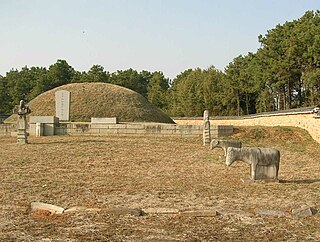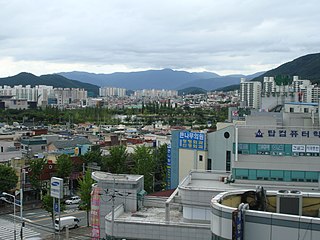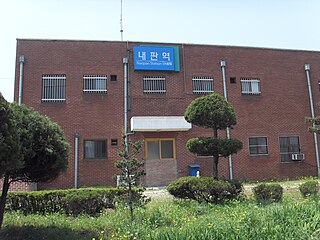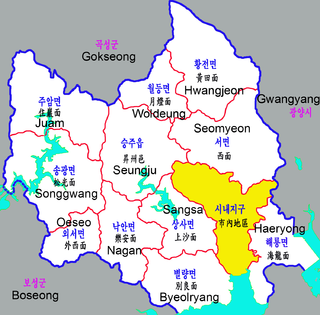
Pohang is a city in the province of North Gyeongsang, South Korea, and a main seaport in the Daegu-Gyeongbuk region. The built-up area of Pohang is located on the alluvium of the mouth of the Hyeongsan River. The city is divided into two wards (gu), Buk-gu or Northern Ward and Nam-gu or Southern Ward.

Cheongju is the capital and largest city of North Chungcheong Province in South Korea.

Damyang County (Damyang-gun) is a county in Jeollanam-do, South Korea. Tourism is a major local industry. Notable local products include bamboo goods and strawberries.

Hampyeong County (Hampyeong-gun) is a county in South Jeolla Province, South Korea.

Namwon is a city in North Jeolla Province, South Korea. Namwon is about 50 minutes from the provincial capital of Jeonju, which is almost three hours away from Seoul. The official city flower is Royal Azalea (철쭉) while the city tree is the crape-myrtle (배롱나무) and the city bird is the swallow (제비). Namwon is a small city located just outside Jirisan National Park, which has the largest set of mountains on the South Korean Mainland. It also borders the Seomjin River, one of South Korea's more prominent rivers. It is 3 hours and 15 minutes from the Seoul Central City Bus Terminal and about one hour from both the U-Square Bus Terminal in Gwangju and the Jeonju Inter City Bus Terminal. It is called "the City of Love" because of the famous Korean love story of Chunhyang. Gwanghallu Garden is a shrine to this love story.

Namyangju is a city in Gyeonggi Province, South Korea. To the east is Gapyeong County, to the west is Guri City, and to the north is Pocheon City.

Pocheon (Korean pronunciation: [pʰo.tɕʰʌn]) is a inland city in the far northeastern region of Gyeonggi province in South Korea. It covers 826.48 km (513.55 mi)2 with a population of 160,176 people, according to the 2008 census. Pocheon lies between Seoul and the mountainous northwestern areas of Gangwon province. The city borders Yeoncheon county, with the cities of Dongducheon and Yangju to the west, along with Uijeongbu, and Namyangju of Gyeonggi province to the south. It also borders Hwacheon county of Gangwon province on its eastern border and Cheorwon is to the north. Alongside the adjoining Gapyeong, Pocheon consists of the highest mountainous areas in Gyeonggi province. The current city of Pocheon was created after Pocheon-hyeon and Yeongpyeong counties were merged. The north part of the city used to be part of Yeongpyeong county while the south used to be part of Pocheon-hyeon.

Gimcheon is a city in North Gyeongsang Province, South Korea. It is situated on the major land transportation routes between Seoul and Busan, namely the Gyeongbu Expressway and Gyeongbu Line railway.

Sangju is a city in North Gyeongsang Province, South Korea. Although Sangju is rather rural, it is very old and was once a key city. Along with Gyeongju, it gives rise to half of the name of the Gyeongsang provinces. Sangju is nicknamed Sam Baek, or "Three Whites", referring to three prominent agricultural products rice, silkworm cocoons, and dried persimmons from the area.

Cheongdo County (Cheongdo-gun) is a county in North Gyeongsang Province, South Korea. It is connected to the national transportation grid by the Gyeongbu Line railroad and the Daegu-Busan Expressway. The seat of government is located in the center of the county, in Hwayang-eup.

Gimhae is a city in South Gyeongsang Province, South Korea. It is the seat of the large Gimhae Kim clan, one of the largest Kim clans in Korea. The Gimhae Kims claim descent from the ancient royal house of Geumgwan Gaya, which was based in Gimhae. Gimhae is situated near the Nakdong River.

Namhae County (Namhae-gun) is a county in South Gyeongsang Province, South Korea.

The Jogye Order, officially the Jogye Order of Korean Buddhism is the representative order of traditional Korean Buddhism with roots that date back 1,200 years to Unified Silla National Master Doui, who brought Seon and the practice taught by the Sixth Patriarch, Huineng, from China about 820 C.E. The name of the Order, Jogye, was adopted from the name of the village where Patriarch Huineng's home temple is located.
Samsung Electro-Mechanics is a multinational electronic component company headquartered in Suwon, Gyeonggi-do, South Korea.
It is the flagship subsidiary of the Samsung Group.

Naepan Station is a signal box on the Gyeongbu Line in Yeondong-myeon, Sejong City, South Korea.

"North Pyeongan Province" or "Pyeonganbuk-do" is, according to South Korean law, a province of the Republic of Korea, as the South Korean government formally claims to be the legitimate government of the whole of Korea. The area constituting the province is under the de facto jurisdiction of North Korea.

"South Pyeongan Province" or "Pyeongannam-do" is, according to South Korean law, a province of the Republic of Korea, as the South Korean government formally claims to be the legitimate government of whole of Korea. The area constituting the province is under the de facto jurisdiction of North Korea.

"South Hamgyeong Province" or "Hamgyeongnam-do" is, according to South Korean law, a province of the Republic of Korea, as the South Korean government formally claims to be the legitimate government of whole of Korea. The area constituting the province is under the de facto jurisdiction of North Korea and China.

Seo-myeon, also called Seo Township, is a myeon (township) in Suncheon, a city in the South Jeolla Province, South Korea. Name of the township means West Township, but it is located in the eastern part, not western part, of the city with a total area of 103.54 square kilometres (39.98 sq mi). The population was recorded to be 12346 people, 6141 males and 6205 females, and the number of houses totaled 4979. The township office is located in 94, Imchondong-gil in Dongsan-ri. There are Bonggang-myeon, Gwangyang in the east of the township, Seungju-eup in the west; Samsan-dong and Wangjo-dong in the south; Woldeung-myeon in the north-west; and Hwangjeon-myeon in the north.

Sangsa-myeon, also called Sangsa Township or Sangsa for short, is a myeon (township) in Suncheon, a city in the South Jeolla Province, South Korea. It is located in the south-central part of the city with a total area of 60.31 square kilometres (23.29 sq mi), 6.7% of a total area of Suncheon City. The population is 2989 people, 1501 males and 1488 females, and the number of houses total 1334. The township office is located in 330, Sangsaho-gil in Heulsan-ri. There are Hyang-dong, Namje-dong, and Dosa-dong in the east of the township; Nagan-myeon in the west; Byeollyang-myeon in the south; and Seungju-eup in the north. Mountains in the township are Oknyeobong (옥녀봉) with the height 549 metres (1,801 ft) on the border to Seungju-eup, and Undongsan (운동산) with the height 465 metres (1,526 ft) on the border to Byeollyang-myeon, etc. Rivers in the township are Isacheon (이사천), Sangsacheon (상사천), Chogokcheon (초곡천), and Seokheungcheon (석흥천), etc. It also has Sangsa branch dam of Juam dam.




















